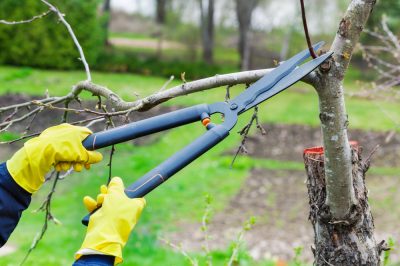When it comes to pruning, of course, is not enough to simply grab the scissors and start cutting. But not only how, but also when is relevant – pruning at the wrong time leads to an unwanted reaction or even high risk of disease.

In the past, trees were usually pruned in late fall or early spring – during winter dormancy. Today, however, tree care experts tend to advise pruning in the growing season between March and September.
Why? Summer pruning is gentler, wound healing begins immediately and there is no danger of frost damage to the wound site. Nevertheless, pruning in winter dormancy has a few advantages over pruning in the growing season.
Contents
Winter pruning: pruning in late fall/winter/spring.
Since time immemorial, deciduous trees and other deciduous woody plants have been pruned in early spring or late winter. Pruning in suitable weather in January or February – well before budbreak – also has advantages:
- No foliage and thus fewer nutrients are removed, thus the tree is weakened less.
- due to the lack of foliage, it is easier to see where pruning is needed
- Winter pruning stimulates increased sprouting in spring, because the reserve substances of all leaves have already been stored and more energy for fewer buds is stored in the roots after pruning.
- Disadvantage: At temperatures <0°C after pruning, frost can penetrate the now open area and damage to the branch or tree can occur.
- So winter pruning brings one thing in particular – wood growth. If I cut my young fruit trees, which should still grow vigorously, this must of course happen in late autumn or in February at the latest. If I prune my 15-year-old maple, which is already getting too big for me, then I should definitely do this in summer to remove foliage and not stimulate growth further.
Summer pruning: pruning in summer/autumn
Meanwhile, in tree care, people tend to prune during the growing season. The tissues are already active and “healing” (compartmentalizing and over-wallowing) of the wounds begins immediately. In addition, pruned trees are less likely to react with new shoots, and “water sprouts”, which are worthless for crown development, occur much less frequently. Advantages of summer pruning:
The tree is still in the middle of growth and can therefore close wounds more quickly.
- Many fungal pathogens are most active in late winter/spring, so infection is more likely then.
- You will have a better view of which branches are taking away too much light and therefore need to be removed.
- Early thinning once again provides the tree with plenty of light and air before the winter break.
- There is no possible onset of frosts that will further weaken the freshly pruned tree.
- Growth is not additionally stimulated because leaf mass is removed – reactions to pruning (water shoots, unintentionally strong and numerous shoots) turn out to be less strong and chaotic.
- Growth is slowed down the most if you cut directly at budbreak – but this also weakens the tree the most.
Summer pruning extends from March to the end of September.
In this period, in principle, you can always cut, but there are certain unfavorable situations:
Midsummer: in July, when it is particularly hot, too much pruning is not advisable. Parts of the crown (the bark) that are normally in the shade are suddenly exposed to direct midsummer sun. This can result in “sunburn”, damage to the cambium and cracking of the bark. This is especially true for tree species with dark bark (e.g. cherry) or with very thin bark (e.g. copper beech).
Strong wind: If trees are exposed to strong wind and weather events and crown sections are suddenly exposed to this wind and weather, e.g. by removing individual long branches, they may break more easily due to exposure.
Old, weakly sprouting tree species: Here one wants to promote sprouting, therefore winter pruning is also justifiable.
Basically, the following applies….
Pruning is possible all year round, but you should know what you want to achieve. If you prune a tree in winter, which is not supposed to grow any bigger, you can simply prune it again in summer. If you want to make major corrections to fruit trees, you should definitely do it in the summer, even if the tree is still to grow. Here, you divide the pruning between summer and winter in the same way.
Background: How does the tree react to pruning?
Trees do not heal their wounds – they seal off. The tree reacts to pruning in the same way as it does to a branch break; at the break or cut, the tissue inside is sealed off so that neither air nor pathogens can penetrate deeper into the wood. The wood tissue that is separated from the healthy tissue by the compartmentalization dies. In addition, the wound is closed again to the outside by a wall. The wood tissue that is separated from the healthy tissue by the bulkheading dies.
The correct cut now determines whether this process can take place quickly and cleanly. In addition, there are bad and good “gravelers” among the trees. If the tree does not manage to successfully compartmentalize and overgrow, slow decay begins from the inside, as decomposing microorganisms can spread in the tree and penetrate deeper and deeper into it.
Research on the subject has shown that trees can carry out this process most efficiently in the growing season between March and September. Cutting during winter dormancy results in larger areas of dead wood tissue. If you cut branches with too large a diameter (>10cm or >5cm in the case of poor “bulkheads”), the tree will not be able to build up the safe barrier between healthy and dead wood tissue.

